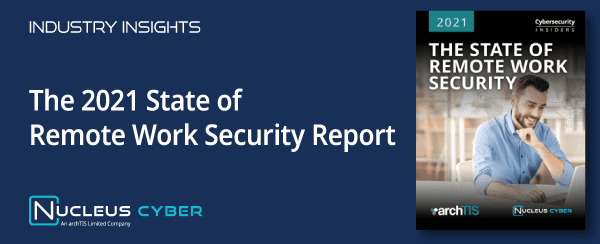2021 State of Remote Work Report Reveals Top Security Issues
A year into the pandemic, organizations are still grappling with how to protect their assets. In a new survey, nearly 80% of respondents see data leakage as the greatest potential threat. The new 2021 State of Remote Work Security Report reveals additional insights into the status of organizations’ efforts to secure the new workforce, key challenges and unique security threats, technology gaps and investment priorities.
The research, conducted by Cybersecurity Insiders, surveyed 287 IT and information security professionals, revealing that:
- Almost three-quarters of organizations are concerned about the security risks of employees working from home, but 86% are likely to support remote working in the future.
- User awareness training (57%), home/public WiFi network security (52%) and sensitive data leaving the perimeter (46%) are the key security challenges for cybersecurity teams in 2021.
- The applications that organizations are most concerned with securing include file sharing (68%), the web (47%), video conferencing (45%), and messaging (35%), which is not surprising given these collaboration tools form the backbone of remote work.
The issue of insider threats has risen over the last few years, as attackers shift tactics to bypass formidable perimeter defenses entirely by stealing credentials. Employee and third party contractor mistakes also account for a growing number of security incidents. Malicious insiders looking to steal company data for personal gain, or to conspire with nation states, is also an alarming trend. As a result, data leaking through endpoints (68%), users connecting with unmanaged devices (59%) and access from outside the perimeter (56%) are the top concerns cited by the cybersecurity professionals.
To better meet the challenge of protecting their remote workforce more than a third (34%) of organizations plan to prioritize human-centric visibility technologies, followed by next-generation anti-virus and endpoint detection and response (23%), improved network analysis and next-gen firewalls (22%), and Zero Trust Network Access (19%).
The reality is that even with user training and visibility, human error is inevitable and working from home is likely to increase that error rate. While innovative security frameworks like Zero Trust network access are a good starting point, securing access to the network is but one variable in the overall security playbook. In order to ensure that a company’s data remains fully safeguarded we must also extend these fine grained controls to the file level, which is precisely the value that Nucleus Cyber and archTIS bring to the market.
Download the report to learn:
- The other top security threats and concerns
- The impact of remote work on meeting compliance mandates such as GDPR and CCPA
- Technology strategies to support the shift to more permanent remote workers
We’re Here to Help
If you’re concerned about data leakage or the privacy compliance implications of remote work, let’s get a conversation started on how we can help.


